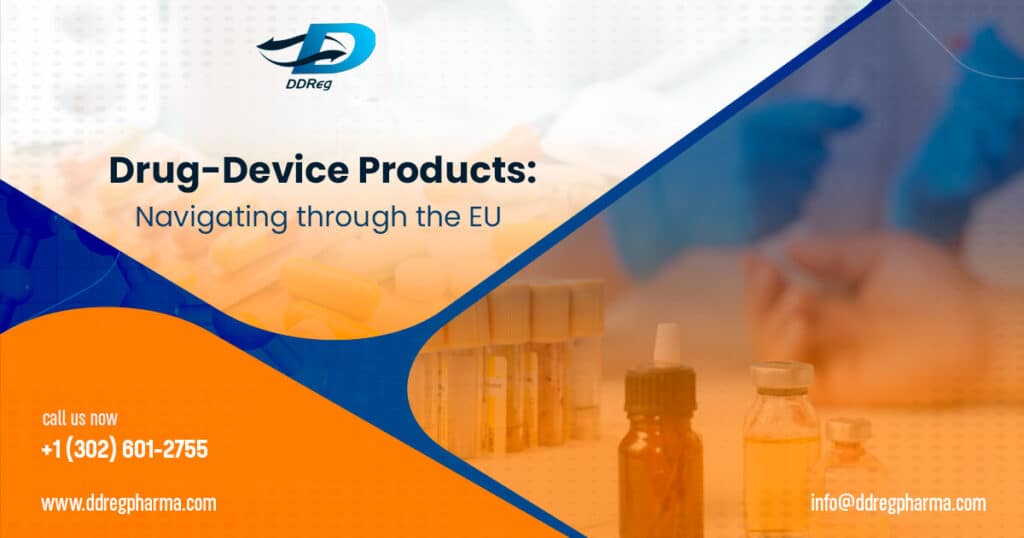Drug-device combination (DDC) products are increasingly demonstrating the value they bring in diagnosing, treating, and curing complex diseases. The growth of the DDC market is driven by several factors including an increase in chronic diseases, a well-established medical technology industry, a rise in surgical procedures, the availability of funding for research and innovation etc. As technology becomes more advance, and innovation goes beyond the horizon, the regulatory approach towards DDC presents certain obstacles, especially when navigating through certain markets that have different or new regulations in place. For example, the approval process for integral combination products has seen certain changes following the EU Medical Device Regulation (MDR) [1]. So, what are some of the key considerations for DDCs when navigating through the EU?
What are the types of DDCs?
There are two types of DDCs: integral, where the device and product form are integrated into one product, and co-packaged where the device and product are separate entities but packed together. In the EU the regulation of DDCs for integral products depends on the medicinal product’s primary mode of action- provided it is the principal and not ancillary to that of the device. Integral products are regulated as medicinal products if the device is intended to administer the medicinal product as a single, non-reusable product. If these criteria are met, integral DDCs are regulated as medicinal products; otherwise, they are regulated as medical devices [2]. Examples of integral DDCs include singe dose pre-filled syringes, drug-releasing intra-uterine devices, and even the dropped on the top of a container with eye drops. Co-packaged devices include nebulisers, oral administration devices, injections needles & filter needles etc [3]
The implementation of the MDR imposed new requirements on manufacturers of integral DDCs. They are now required to obtain a separate opinion from a designated notified body (NBOp) and include it in the marketing authorization application (MAA) submission. This process represents a significant investment of time and resources for manufacturers [3].
At what point an NBOp is required for the DDC?
To distribute a medical device in the EU, it must have CE marking, indicating compliance with relevant regulations for safety and performance. Under the Medical Device Regulation (MDR), Article 117 mandates that integral DDCs regulated as medicinal products must have CE markings for the device component. If the device lacks CE marking, the involvement of a designated notified body (NBOp) is required. Compliance with the general safety and performance requirements (GSPRs) specified in Annex I of the MDR is crucial. These requirements encompass aspects such as risk, performance, design, manufacturer information, and Labelling. Manufacturers must identify the relevant GSPRs and ensure compatibility and with interoperability other devices or substances [1].
What elements should be incorporated in the NBOp submission?
Following are the key components to be included in the submission for a device part of an integral DDC as per the NB Position Paper on the documentation requirements for DDC products [4] –
- General description of the device,
- Instructions and inserts,
- Contra-indications and warnings,
- A checklist of applicable requirements,
- Principles of operation and mode of action,
- Conformity demonstration methods and results,
- Description of accessories and other related devices/products,
- Adopted methods to meet requirements,
- Raw material details,
- Identification of applicable standards,
- Technical specifications
- Controlled document information.
What are the labelling and UDI requirements for DDC products?
The Labelling and Unique Device Identification (UDI) requirements of the Medical Device Regulation (MDR) do not apply to integral DDCs which are regulated as medicinal products. In such cases, the integral DDC manufacturer should adhere to the Labelling requirements set for medicinal products, and device-part-related UDIs should not be included in the Labelling or packaging of the integral DDC [3].
For co-packaged combination products where the device part requires CE marking and compliance with MDR requirements, the device-related information (manufacturer, CE mark, UDI) should be provided on the device or its packaging within the outer packaging. However, the medicinal product information should not contain any device-related details.
If the device part of a DDC is CE marked, the product labelling for the integral DDC should follow the labelling requirements for medicinal products. If a UDI is already directly marked on the device part, it does not need to be removed. Importantly, the UDI should not be displayed on the Labelling or outer package of the medicinal product [3].
Conclusion
DDCs are a significant focus within the market and can be classified into two types: integral and co-packaged. Integral DDCs manufacturers are required to seek NBOp’s opinion for obtaining marketing authorization as per the MDR. The necessity for an NBOp is determined by the presence of CE marking on the device component. Submissions to the NBOp should encompass various components, including device description, instructions, contraindications, checklists, and demonstration of conformity. The Labelling and UDI requirements vary depending on whether the DDC is regulated as a medicinal product or a medical device, with specific guidelines provided for integral and co-packaged DDCs.
References and Further Reading
[1] European Commission. Medical Device Regulation. 2017
[2] EMA. Questions and Answers for applicants, marketing authorisation holders of medicinal products and notified bodies with respect to the implementation of the Medical Devices and In Vitro Diagnostic Medical Devices Regulations ((EU) 2017/745 and (EU) 2017/746). European Medicines Agency. 2021
[3] EMA. Guideline on the quality requirements for drug-device combinations. European Medicines Agency. 2019
[4] Team NB. Team-NB Position Paper on Documentation Requirements for Drug Device Combination Products Falling in the Scope of Article 117 of MDR 2017/745. The European Associate Medical Devices- Notified Bodies. 2020

